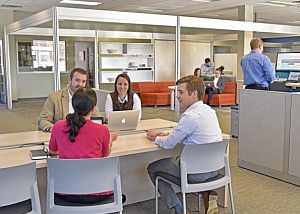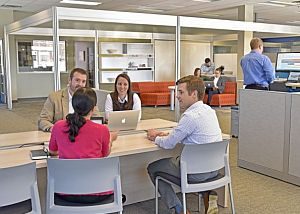What You Need to Know about Flexible Office Design
09/21/2016

Many organizations are rethinking how they design and use their office spaces and the term “flexible office design” is heard more and more. When designing a flexible office, there are many different aspects a company must consider to ensure that the design best reflects the needs of the company and its employees, and to make the transition successful and sustainable in  the long run. According to Fortune, the next generation of offices, the flexible design office, combines each of the following features to create the ideal office space:
the long run. According to Fortune, the next generation of offices, the flexible design office, combines each of the following features to create the ideal office space:
- Private offices
- Cubicle banks and truly open floor plans
- Cubicle dividers that are dismantled
- Communal areas (e.g., kitchen/café work zones; lounge seating areas)
- Sound-proof rooms for solo work
A study done by the architecture and design firm Gensler revealed that time spent on focused individual work increased from 48% in 2008 to 54% in 2013, demonstrating that the flexible office design is the way of the future, allowing employees to utilize private workspaces when they need to focus on individual work. With any major renovation or remodeling of an office space, employees often require some coaxing and training to begin to fully utilize all the features of the space. Below are some points to consider and watch-outs for the transition into having a flexible design office summarized from the British firm Ergonomi.
Things to consider
- Workplace change requires visible positive support from senior management.
- Conduct organizational behavior training to initially help employees optimize their use of the dynamic aspects of the flexible office design.
- Provide height adjustable workstations, provide proper training on good ergonomics, and encourage employees to take the time to adjust their workstation to fit their needs anytime they move to a new location.
- IT support is critical to ensure all workstation are functioning properly if employees are going to be checking in and out of different locations throughout the day.
“Watch-outs”
- Having a flexible or open office can dissolve the distinction between work and personal life.
- Mobile technology, which is necessary for employees working in an open or flexible office space, also eliminates a clear endpoint to the work day.
- Mentoring relationships may not develop as naturally in an open or flexible office design setting.
- Employees may adopt traits to communicate their privacy requirements. For example, wearing headphones = no interruptions.
One final point to consider in this global economy that we live in, is that attitudes toward personal office space differ greatly across cultures. The global research firm Ipsos conducted a study for Steelcase on office spaces and workers in 14 different countries.
Table 1: Office Space Allocation for Employees by Country
| Country | Square Footage |
| Germany | 320 |
| United States | 190 |
| India | 70 |
| China | 50 |
Germany had the highest square footage allocation of all countries studied. Interestingly, despite their relatively dense workspaces, both Indian and Chinese workers rated their environments highly in terms of their ability to concentrate and work without disruption. This further demonstrates that culture, whether it be that of a nation or that of a company, can truly impact the way that open or flexible office designs are accepted and utilized.






